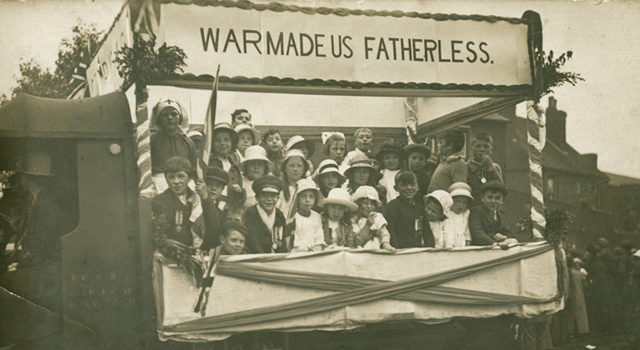Articles
No Comments
By Voices
On 11, Feb 2014 | No Comments | In Childhood | By Voices
Children’s Lives in the Great War
Children’s Lives Project
www.connectinghistories.org.uk
Home held a powerful symbolism during World War 1. Men went to the Front to fight in defence of hearth, home and family and this was the message carried by many recruitment posters. On the home front German zeppelin raids over British cities were seen as a war against women and children.
Taking a family photograph with father in uniform before he departed for the front became a ritual of memory.
This photograph of the Parsons family of Halesowen, 1915, shows Abednego Parsons, his wife Fanny, and their daughters Sarah and Norah. Abednego was a Private in the Royal Army Medical Corps and served in France. He survived and returned home at the end of the war. The family is shown in a conventional studio pose with the father standing behind the mother.
Recruitment posters readily used imagery featuring children to tug on the heart strings of fathers to encourage them to enlist.
Very young children might have only the vaguest recollection of a father who would not return for years, if at all. The scale of the casualties left around 350,000 children across the UK without a father. This photograph shows fatherless children on a Birmingham Co-operative Society float at the 1920 May Day parade. Other fathers returned, but were wounded or scarred by psychological conditions such as shell shock. Across Europe, parents grieved for sons they had lost.





![Family Portrait, 1915 [Library of Birmingham: LE]](http://www.voicesofwarandpeace.org/wp-content/uploads/2014/02/family-portrait.jpg)
![Recruitment poster for the Warwickshire Volunteer Regiment [Library of Birmingham: LE]](http://www.voicesofwarandpeace.org/wp-content/uploads/2014/03/ww1-worth-defending.jpg)
![Recruitment poster, 1915 [Library of Birmingham: LE]](http://www.voicesofwarandpeace.org/wp-content/uploads/2014/02/ww1-men-of-britain.jpg)
![Co-operative Society May Day float, 1920 [Library of Birmingham: WW1 Home Front]](http://www.voicesofwarandpeace.org/wp-content/uploads/2014/02/ww1_fatherless-children.jpg)

Submit a Comment